Does High-Tech Cooking Have Soul?

On the second shelf of a makeshift liquor cabinet in my apartment in Brooklyn, New York, there is a memento from a Thanksgiving past. It is a tomato-red oven mitt, the thumb of which is singed so badly the stuffing pokes out, suspended inside a shadow box frame. The mitt was a gift from my aunt, who, in a frenzy of lightning-round cooking, once handed me a dish of stuffing that had caught fire in the oven. When I protested, she motioned for me to hustle it to the table.
It is hard for me to conceive of a cooking experience that doesn't involve negotiations with heat, a cacophony of sounds and a tangle of smells. For me, the pleasure of preparing a meal (besides serving it and eating it, of course) is visceral. I love the scent of bacon grease and the sound of the whirring fan in the oven hood. I am lulled by a hand-cramping hour of stirring polenta. My most cherished cooking memories are the ones marked by burnt tongues, tricky pilot lights and imperfectly browned vegetables. But this year, I decided to go modernist, sleek and flame-free. My goal was Thanksgiving dinner made entirely with high-tech cooking equipment—the kind of shiny, stainless steel appliances, with display screens and touch pads, that do silent, odorless work. A sous vide machine created for at-home use. A state-of-the-art induction burner. A newfangled electric pressure cooker.
The aim was to find out whether using these appliances resulted in a more delicious dinner. It was also to find out if the experience of cooking with equipment designed to minimize human error—to make preparing a meal easier, faster and less messy by keeping the human mostly out of it—was somehow less fulfilling than cooking the old-fashioned way. Would food made in a machine that looked like R2-D2's baby brother taste better than food made with a wooden spoon and a sauté pan? I was certain it would not. I was also certain that, having done more pushing of buttons than fending off of flames, I would be putting this Thanksgiving dinner on the table feeling a little empty inside.
Kitchen Gadgets: Sous Vide
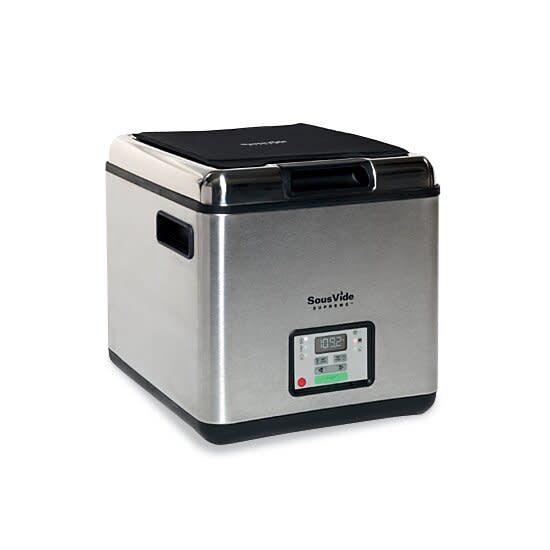
Courtesy of SousVide Supreme
I began with brussels sprouts, the essential and uncomplicated side that my mom and I make every year. I was using the SousVide Supreme, a breadbox-size stainless steel machine, to cook them. But the process began just like it always does—with 20 minutes of prep. (What would really be technologically advanced, as my husband observed from behind a pile of sprout trimmings, is a piece of equipment that washed, dried and cut vegetables for you.
Sous vide, which translates to "under vacuum," is a technique developed in the 1960s by Swiss engineers that cooks vegetables and proteins inside a sealed, airtight plastic bag set in a water bath that stays at a consistent, low temperature. The engineers who devised it intended it as a method of food preservation; vegetables and proteins cooked sous vide and refrigerated can last several days beyond their usual shelf life. In this century, though, it has become a cooking method that combines the intimidation factor of all things gastronomical and French-sounding with the intimidation factor of all things in the purview of culinary giants like Thomas Keller, Jo?l Robuchon and Ferran Adrià, who create food light-years beyond what a home chef in her right mind would attempt. In my home though, the process felt curiously mundane, like throwing a load of laundry in the dryer. I fed the edges of plastic bags containing seasoned brussels sprouts and knobs of butter into a vacuum sealer, waited as the machine suctioned the air out, and dropped the parcels in their 85-degree-Celsius water bath.
Now, these were middling brussels sprouts. They were from a regular supermarket, not a farmers' market. They were a little too big and a little off-color. But what came out of that water bath were brussels sprouts. After a quick browning, and even before I dressed them up with glazed walnuts, crisp pancetta and a splash of balsamic vinegar, they tasted excellent. The brussels sprouts had suffered no flavor loss; their delicate floral shapes had been perfectly preserved. My skepticism wobbled. Unless these improbably flavorful brussels sprouts were a fluke, sous vide is a nearly effortless cooking method that can make even mediocre vegetables taste like gold-medal winners. (Note: Chefs will tell you that sous vide preparation can't make subpar ingredients taste better. It can.) It is also a cooking method that can turn a 45-minute process into a two-hour one; sous vide vegetables take about an hour to an hour-and-a-half to cook. Of course, those are hands-free, sweat-free hours during which you can do things like blanch onions or prepare pie crusts. Or nap—which, as the mother of a two-week-old, is what I did.
Kitchen Gadget Details:
The breadbox-size SousVide Supreme works by cooking food sealed in an airtight bag at a very low, steady temperature in a water bath. It is near-silent, odorless cooking. You'll also need plastic bags and a vacuum sealer ($129) to get started. $399; sousvidesupreme.com.
Kitchen Gadgets: Induction Burners
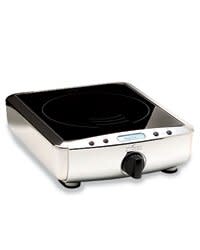
Courtesy of All-Clad
The science behind sous vide is actually fairly low tech—hot water cooks stuff. But my induction burner, a curvy, silvery countertop appliance about half the size of a microwave, was driven by technology that I barely understood: A high-frequency electromagnet in the burner reacts with steel or iron (and it must be steel or iron) cookware to generate heat—lots of heat. My model had 10 numerical settings for low to high heat and seven settings calibrated to a specific cooking method—boil or fry, for instance. Small restaurants and caterers like induction burners because they are portable and do their work scarily fast. I set the burner to medium for the brussels sprouts, and the grapeseed oil was hot in about 30 seconds—which is less of a bonus for those of us who spend the minutes it takes for oil to heat finishing the prep work. What transpired looked like cooking. It felt, vaguely, like cooking. But it was almost as if a cooler, calmer, more skillful avatar of me had done the work. Because the burner throws off almost no heat, I was literally cool. The pan sat on its smooth ceramic glass surface so evenly, I didn't have to shake it to battle hot spots. When the task was complete, I had a dry brow, a casual air and picture-perfect brussels sprouts. I felt, in a not totally unpleasant way, like Sandra Lee. But I kind of missed my rickety stove. I think I'd prefer to fuss with my crooked gas burners and wait a few minutes for the oil to heat than plug in the induction burner every night. There is somehow comfort in the fussing.
Kitchen Gadget Details:
Powered by an electromagnetic field, induction burners like this one by All-Clad cook 50 percent faster than traditional stoves, while staying cool to the touch. They are great at holding precise temperatures (useful for frying), and the tops wipe clean with soapy water. $399; surlatable.com.
Kitchen Gadgets: Pressure Cooker
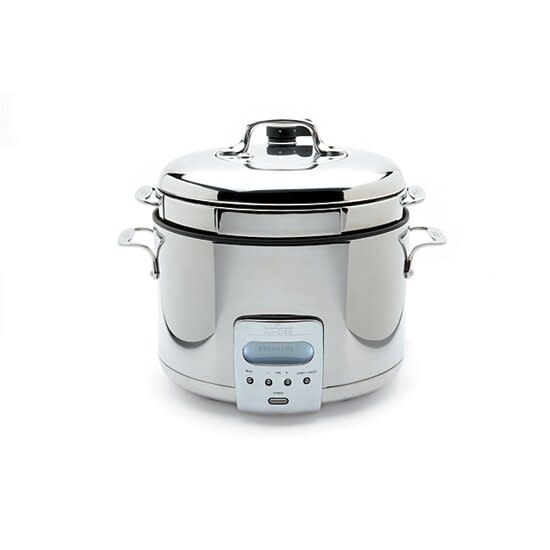
Courtesy of All-Clad
The mashed potatoes I assigned to the pressure cooker. The new 21st-century pressure cookers are nothing like the original Eisenhower-era stovetop incarnations, which clanged like steam trains and had a reputation for occasional explosions of lava-hot food. Pressure cookers are very big with the cutting-edge chef crowd these days (billionaire gastronaut Nathan Myhrvold touts them in his recent six-volume tome, Modernist Cuisine), because they extract intense flavor in about a third of the normal stovetop cooking time.
The manual for the model I used promised me I could make mashed potatoes in six minutes. Six minutes! Ordinarily, that's a feature I would reflexively reject. Ease is out of fashion in certain circles these days, my circle included. I may not have taken up churning my own butter or milling my own wheat, but I have mentally cast my lot with the amateur butchers and beekeepers, the spit roasters and the picklers. However, the pressure cooker actually produced mashed potatoes that were flavorful, sumptuous, comforting—everything that makes mashed potatoes crowd-pleasers. I added peeled potatoes and a small amount of milk to the pot, sealed the lid, and six minutes later, they were ready for mashing. There was no boiling of the potatoes or late-night scrubbing of boiled-potato film; it was a one-pot endeavor, as advertised.
Kitchen Gadget Details:
All-Clad's new version of the decades-old device is electric, programmable, energy-efficient and speeds up cooking times by more than 50 percent. Plus, new safety features ensure that explosions of dangerous steam are a thing of the past. $299; surlatable.com.
Kitchen Gadgets: Pressure Pan
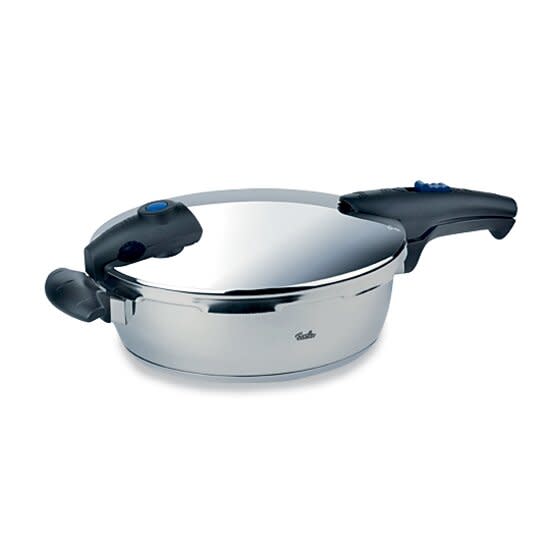
Courtesy of Fissler USA
As it turns out, if a piece of high-tech equipment does something cool and helpful enough—if it takes a task I'm not that sentimentally attached to and shortens it measurably—I'm quick to adapt. Take stuffing. I'm a stuffing obsessive. My cousin and I have been known to elbow past 80-plus-year-olds to get to it first. It's the elbowing of relatives and the eating of stuffing that I hold dear. The cooking of it? Far less so. I tackled this year's version in a pressure pan, a streamlined descendant of the pressure cooker that gets its heat from the burners on your stove rather than an electrical outlet. It also has an airtight lid that snaps on, trapping the steam, increasing the pressure and raising the boiling point of the liquid inside. This allows you to go through the motions of traditional cooking, but in about an eighth of the time. The pressure-pan version of my mother-in-law's stuffing wasn't actually better than the traditionally prepared dish, but it was done more quickly, and the knee-buckling aroma kicked up from the onions and celery softening in butter was present as usual. The shorter task felt no less Thanksgivingy in the end.
Kitchen Gadget Details:
Like a pressure cooker, Fissler's short, chubby pan has an airtight lock-on lid that traps steam to build heat and pressure. But unlike a pressure cooker, you use it on a stovetop's burner and can sauté and brown ingredients inside before shutting the top. $265; fisslerstore.com.
And then there was the turkey. Did these sleek, stainless steel appliances get me any closer to the burnished, crispy-skinned, moist-fleshed looker that my family would remember for years? They did not. The SousVide Supreme can't hold much, so I broke down a whole turkey, packed up the breasts in plastic bags with butter and herbs, and tucked them into a nice 140-degree-Celsius bath for two hours. They came out beautifully. Did I miss the basting? The fretting over oven calibration and dryness? Not as much as I thought I would. Besides, I had the satisfaction, if you can call it that, of properly screwing up the turkey breasts when I browned them. Neither the moist sous vided flesh nor the glossy, smooth surface of a high-performance induction burner could stop me from letting the turkey breasts brown too long and at too high a heat; they ended up too tough to be called the best we'd ever had.
As a purist and a romantic, I was prepared—eager, even—to conclude that cooking with sterile-looking appliances that beep like hospital heart monitors wouldn't feel good. But, if I had the budget and the space, I'd definitely keep an induction burner on hand for perfectly calibrated frying and high-heat searing—the kind my stovetop could never accomplish.
Would I make risotto in that pressure pan, as the manual suggests, slicing the cooking time by two-thirds? Never. If I'm choosing to make risotto, I'm choosing the kind of cooking that uncoils the springs in my brain and takes me away from my day. I don't see the point of making risotto any other way. On the other hand, faced with a family clamoring for mashed potatoes, I will be making those in six minutes, and I will not be feeling empty inside about it. And while I might not pass a cobalt-blue sous vide machine down to my granddaughter the way I would my Le Creuset, I won't be banning one from my kitchen, either. Especially because I know that my own grandmother, if I could tell her, would be thrilled to know I was able to make Thanksgiving dinner for our family in half the time, with a burn count of zero and a newborn in the crook of my arm. She wouldn't see that as sacrilege; she would see that as progress.
Katherine Wheelock is a writer and editor who has contributed to the Wall Street Journal, GQ and Details. She also works for the restaurant Roberta's in Brooklyn, New York.
More Thanksgiving Recipes & Tips:
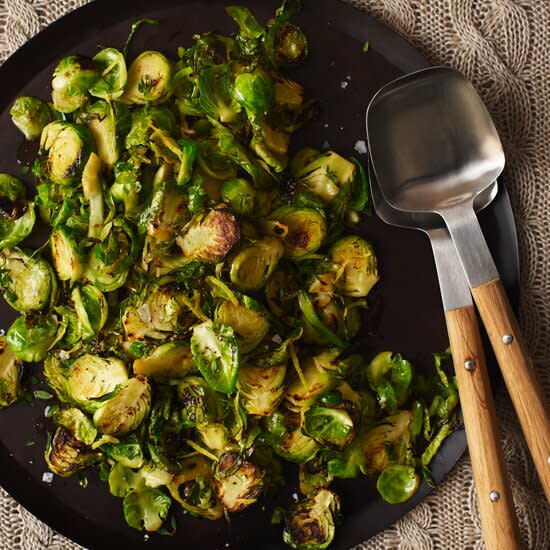
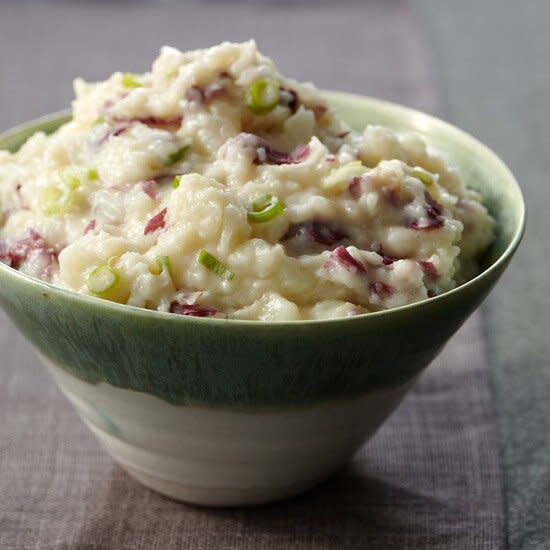
?? Lucy Schaeffer
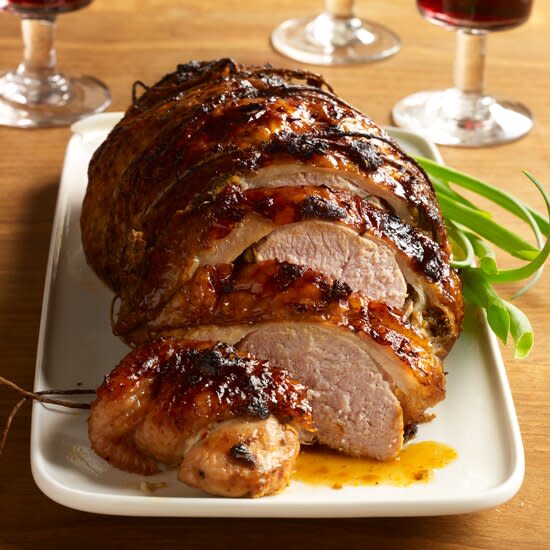
Fast Thanksgiving Turkey Recipes